Springtime at Sagawau Canyon and Chicago Botanic Garden
A while ago I noticed how much open space there is in the southwest suburbs near J. and, after a trip to the Hal Tyrell Trailside Museum, realized that much of it runs alongside the Des Plaines River and other waterways and belongs to the Forest Preserve District of Cook County (FPDCC). We’ve visited Hal Tyrell, Chicago Botanic Garden, Sand Ridge Nature Center, Tampier Lake, Swallow Cliff Woods, and Waterfall Glen (Forest Preserve District of DuPage County), but the more we drive around and the more information and maps I pick up, the more I understand the extent and diversity of FPDCC’s natural richness and how important it is to the quality of life in this sprawling mass of urbia-suburbia. If I had a family and could drive, they might hate me because I’d drag them to the FPDCC and its programs spring, summer, fall, and winter. No matter the season, there’s something to see or do (naturally, snow helps in winter).
Being a facebook fan of the FPDCC has paid off before, but last week’s announcement especially interested me — the grand opening of the Camp Sagawau Environmental Learning Center. I’d never heard of Sagawau, and when I looked it up discovered that it’s the only canyon in Cook County. After our visit to Starved Rock’s French Canyon, this seemed like a must-see. Twenty percent of the world’s dolomite prairie is located at Sagawau, too. It sounded truly unique.
A lifelong resident of Cook County, J. had never heard of it. Naturally, he was intrigued.
On Saturday, April 17, after an early start for him and an al fresco breakfast at Bonjour, we headed toward Orland Hills/Orland Park. Along the way I saw two hawks pass overhead. It’s that sort of possibility that makes me appreciate this less developed part of Cook County. He said he’d seen owls perched on the light standards.
He dropped me off at PetSmart (Orland Hills) while he went to his doctor’s (Orland Park). It was a pretty easy hour to fill. After peeking into the pet hotel, the dog camp, and the spa, and locating what I wanted to get, I checked out the cats up for adoption. Ranging from 9 months to 10 years old, most were from high-kill shelters (isn’t that an oxymoron?). One was an owner surrender. The reason? “Time.” I found this suspect, as did another woman who was looking at them. Cats are low-maintenance creatures; “travel” might have made more sense. All of them seemed sweet.
At Sagawau, local police directed us into a nearly full parking lot — popular event! We found a spot only because someone must have just left.
While we waited 20 minutes or so for the canyon tour, J. photographed the farmhouse and a downy woodpecker among the European starlings in the trees. At this point, all we knew about the canyon walk was that our feet would get wet. We had no idea what lay ahead.
In the past two weeks, spring has burst out all over, and nowhere is this more apparent than in the surrounding woods here, where purple-flowered trees shaded blue flowers, and the bird chatter was incessant.
A group gathered around the naturalist, an older woman. A former teacher for 35 years, she is an amazing educator. Before we went into the canyon, she provided us with the human and geological history of the area. The 1800s farmhouse, complete with vintage telephone resistors and recent porch additions, belonged to a man whose successive wives didn’t care for its remoteness from the bright lights of the big city. The boys of the group learned that there were no televisions, radios, Internet, or cell phones. “Computer games?” No computer games. Inconceivable! She did assure one boy, who seemed to be 7 or 8, that he would have been kept busy enough breaking trails through the ice and snow, milking cows, and performing other chores. The horror!
She asked another boy to die, which he did by flopping onto the ground dramatically. When he tried to get up, she told him to stay dead. He represented the organisms that died and whose remains formed the sedimentary rock of the area. A girl was instructed to eat some of his arm as part of the process. Next, two tall, thin, older teenagers, dressed in black and sporting chains and piercings, were told to represent the glaciers and to make bulldozer noises. A couple of other children, joined the first boy as dead coral, and J. and another man added to the force of the glacier bearing down on the rocks before they were told to “melt away.” The teenagers seemed to have great fun watching the kids and then participating. Later I would hear them talk about pulling garlic mustard. Afterward, I learned from their conversation with the naturalist that they volunteer and have a particular interest in eradicating said invasive garlic mustard. As we were leaving, we saw them riding off on their bicycles — metal heads with a love of nature. There went my stereotypes.
To get into the canyon, you walk down steep wooden steps wide enough for just one person — in my case, I wondered if they were wide enough for my one person. (Yes. Barely. Not unlike one of my dream fears.) Our group was large, and we were at the back, so there wasn’t a lot of room left to stand at the bottom. It was here that the naturalist began to hint that this might not be a walk in the park, or even a simple wade through a little water. The rocks, she informed us even as some of us balanced tentatively on them, are slippery, and many are pointy (not flat) or loose (both the pointy and flat ones).
She asked if the shadows in the canyon wall were caves (I missed the answer) and if you had been one of the area’s Indians, would you have hidden in them during a rainstorm? Answer: Only if you wanted to drown in the rising waters, which she said end up in the Gulf of Mexico. She also noted that in spots the opposite walls of the canyon seemed to fit together like jigsaw puzzle pieces and mentioned earthquakes.
As she talked, she or someone spotted a hawk overhead; she pointed out that it was circling. “What is it doing?” she asked. I didn’t catch what someone answered (I’m guessing, “Uh, flying?”), but she said, “Riding the thermals.” Meanwhile, the little boy with the couple next to us started to squirm and say, “Can we go?” Too young to appreciate the fabulous experience. I remember and regret those days.
At one point our guide noticed a couple of young women walking above us along the edge. After saluting them, she gently but firmly suggested that they back off because the edge is not very stable. Startled by this revelation, they scuttled off.
It came time to cross the stream, which, from where I stood, seemed easy enough. I was more concerned about the necessity of climbing out of the canyon, as I envisioned scaling the uneven vertical walls. The warning that the rocks are slippery was illustrated when someone said one of the first boys to cross fell on the rock (#9 hardness). For someone like me who is adept at falling, this didn’t bode well. Our guide had told us to stay in single file and to hold hands. “None of us has cooties.” Against my desire to be independent and adventurous, I found myself reaching for J’s arm, often at a moment when he was struggling to find his own footing. I slipped once or twice, but didn’t fall. While balancing on one rock, I’d test the next with my foot. If it moved, I’d rock it to see the extent of its instability. Intuitively, I had found an effective way to reduce the risk of an embarrassing (or worse) mishap. This approach slowed me, but I wasn’t in a hurry, and neither was anyone else.
The day was really perfect for all of this — beautifully sunny with deep blue sky and a temperature in the 50-degree range — not cold, not warm, although both of us worked up a little sweat.
Crossing the stream lower down (higher up?) was more of a challenge, with smaller, pointier, more slippery, and more unstable rocks. By now, too, muscle fatigue was settling in, with all the standing during the talk near the farm house and then in the canyon while balancing on uneven rocks. My footing, never sure, was less so as my muscles weakened and trembled. The woman in front of me, with her husband and little boy (the one who wanted to go) was younger and fit, but she struggled a bit, too. I told her I had figured that if the naturalist, who appeared to be 60 to 65, could handle this, I should be able to as well. She admitted she had thought the same thing. We had this conversation as we were headed toward the way up. This involved going along the canyon wall — not too bad in a few places, but in others there are wide gaps between the rocks in the water (not a problem for those with longer legs like J.); in others there’s little solid ground along the edges, so you cling to the walls outcroppings with your hands and hope that your trembling legs and tentative balance don’t give out. Of course, J. was carrying his camera bag (bulky), and I had my tote bag with binoculars and field guide (heavy), which didn’t help. AS I tell him, serious hikers need to have both hands free (and, of course, I’m not afraid to leverage my butt if need be).
With hand holding from the boy’s father and J., I made it to the exit, which proved to be the easiest part of the walk. It was angled with unevenly spaced ledges serving as steps, which my trembling legs could handle. At the top, I used my butt as my third hand and instantly felt relieved and triumphant that I hadn’t humiliated myself. Really, I don’t think it’s everyone who’s my age and weight who would undertake even such a modest challenge.
We took a quick look around the new environmental learning center, which seems to be well designed from environmental, aesthetic, and practical perspectives. The enormous fireplace is a lovely touch, as is the wall of quotations on a curved wood wall embracing the television screen, where a film about butterflies was showing. I especially liked this one:
For if one link in nature’s chain might be lost, another and another might be lost, till this whole system of things should vanish by piece-meal. (Thomas Jefferson, 10 March 1797. Transactions of the American Philosophical Society.)
After a brief detour to Walgreens, we set out for the antique and garden fair at the Chicago Botanic Garden and arrived within 40 minutes, leaving enough time to walk through some exhibits and for J. to buy vintage strawberry baskets as well as roam the gift shop. I, on the other hand, made it only through the first tent before finding a place to sit — I’d done enough standing by the farm house and in the canyon to ache all over. But it was the good, honest ache of needed exertion.
After the gift shop closed, we walked around the English walled garden, then past the waterfall to the Japanese islands. Walking I could handle. On the way back I spotted a sign telling us to look up about 20 feet to see a “witch’s broom” in one of the conifers, a mass of growth that looks like a squirrel’s nest and that can be used to start a new tree. I love the name — trees are, after all, magical.
Neither of us had eaten since breakfast. Breakfast? We went to Walker Bros. (The Original Pancake House) in downtown Highland Park — garden vegetables pancake for him, Mediterranean omelet and a half order of chocolate chippers (for later) for me. Mmmm. The moon was just a silver sliver in the night sky when we left.
At the Flamingo, I had to use the cart to haul all the loot from PetSmart to the elevator and my apartment. Poor, deprived Hodge.

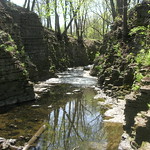





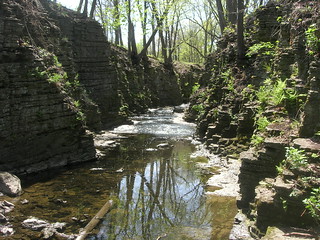
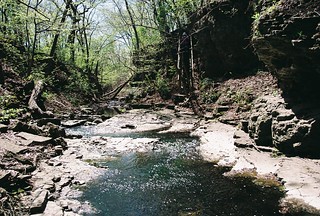


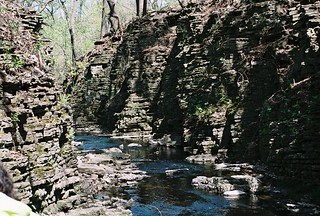


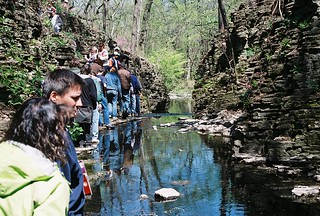

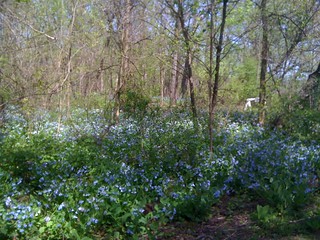
Comments
Springtime at Sagawau Canyon and Chicago Botanic Garden — No Comments
HTML tags allowed in your comment: <a href="" title=""> <abbr title=""> <acronym title=""> <b> <blockquote cite=""> <cite> <code> <del datetime=""> <em> <i> <q cite=""> <s> <strike> <strong>